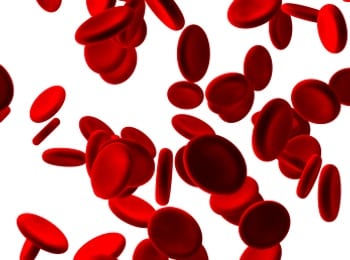
Doctors routinely order the complete blood count (CBC) for their patients because they can learn a lot about a person’s health by measuring the numbers of different types of blood cells in the circulation, their sizes and the ratios between them.
One component of the CBC is usually a measure of the total amount of hemoglobin, the oxygen carrying protein found in red blood cells. Low levels of hemoglobin can be a sign of nutritional deficiency, autoimmune disease or bone marrow problems, and may result in fatigue, irregular heartbeat and poor growth in children. Abnormally high levels of hemoglobin can be caused by heart failure, COPD or kidney cancer and are associated with increased risk of stroke.
New research published online in the journal Nature Genetics this week identifies two SNPs that account for a small amount of the variation in hemoglobin levels seen in the population and may help scientists find new ways to treat blood disorders.
John Chambers and colleagues analyzed the DNA from more than 11,000 Europeans in England and Finland and more than 16,000 Indian Asians living in London. They found and both impacted hemoglobin levels.
In both the European and Indian study groups, each A at and each G at led to an approximately 0.1 gram per deciliter (g/dL) decrease in hemoglobin levels. The normal range for hemoglobin levels in adults is 12 to 18 g/dL.
Approximately 25% of the world’s population has hemoglobin levels low enough to be considered anemic. The World Health Organization has deemed anemia a severe public health problem in India. Although nutritional iron deficiencies are a large part of the problem in this and other countries with high levels of anemia, it is interesting to note that the versions of and that lead to lower hemoglobin levels were found at higher frequencies in the Indian study subjects.
Both SNPs identified in this study are in or near genes involved in regulating the body’s iron levels. One of the SNPs is near the HFE gene. Mutations in this gene cause hereditary hemochromatosis, a condition that can result in iron overload. The researchers found, however, that the effect of is not related to these mutations. Another SNP is located in the TMPRSS6 gene. Mutations in this gene have been shown to cause a serious form of anemia that does not respond to treatment with oral iron supplements. Chambers says that learning more about how this gene contributes to hemoglobin levels could lead to new treatments for people suffering from chronic hemoglobin problems.
“The enzyme protein produced by the TMPRSS6 gene is a good target for drug development. Designing a drug that enhances TMPRSS6 activity could augment hemoglobin in people such as cancer and kidney failure patients, who suffer from chronically low levels. A different drug that blocked TMPRSS6 enzyme production might bring down high hemoglobin levels,” he said in a statement.
Several other reports published online this week in Nature Genetics (Benyamin et al., Soranzo et al. and Ganesh et al.) also examined genetic contributions to blood traits. These will be covered later this week here in the Blog. Benyamin et al. and Ganesh et al. also both found evidence for an association between and hemoglobin concentration.